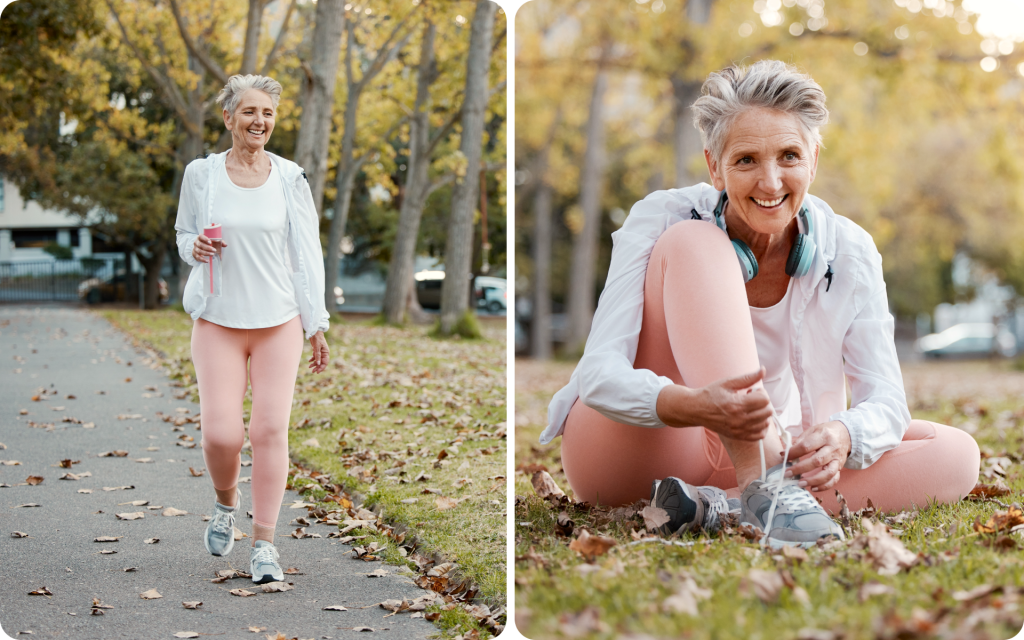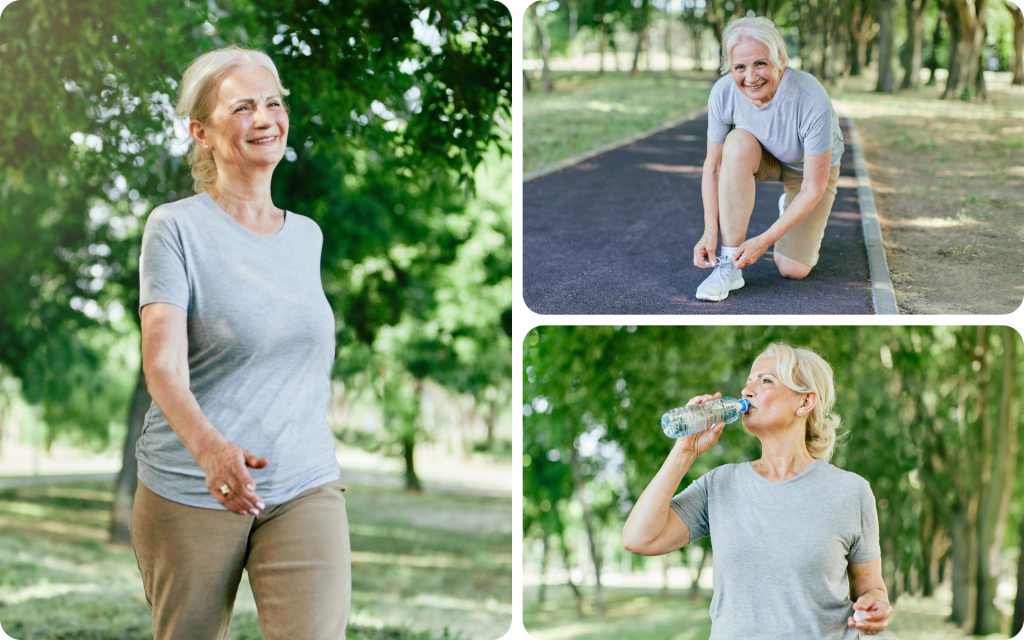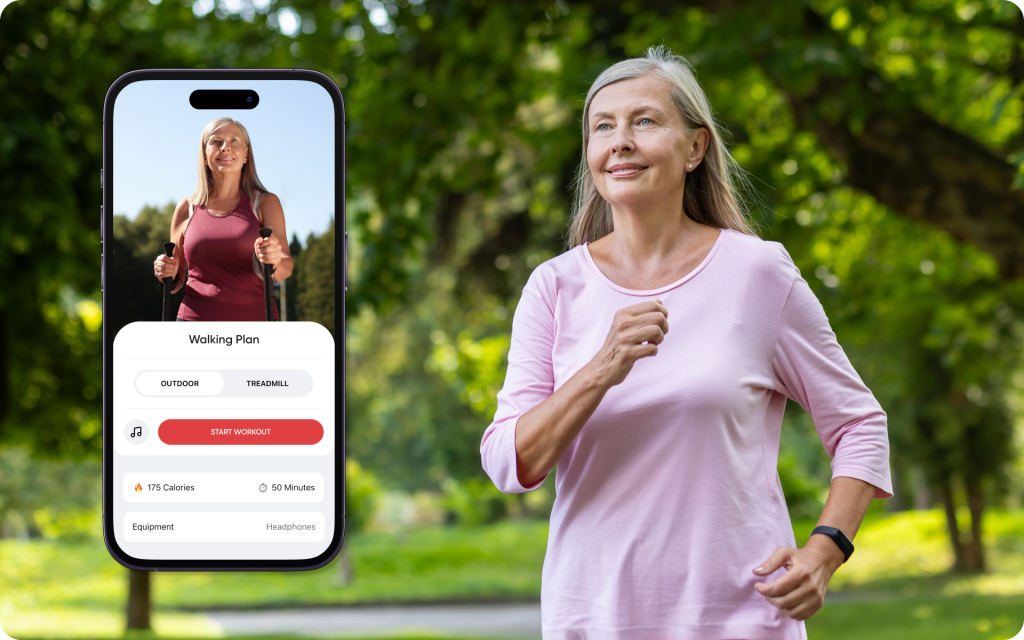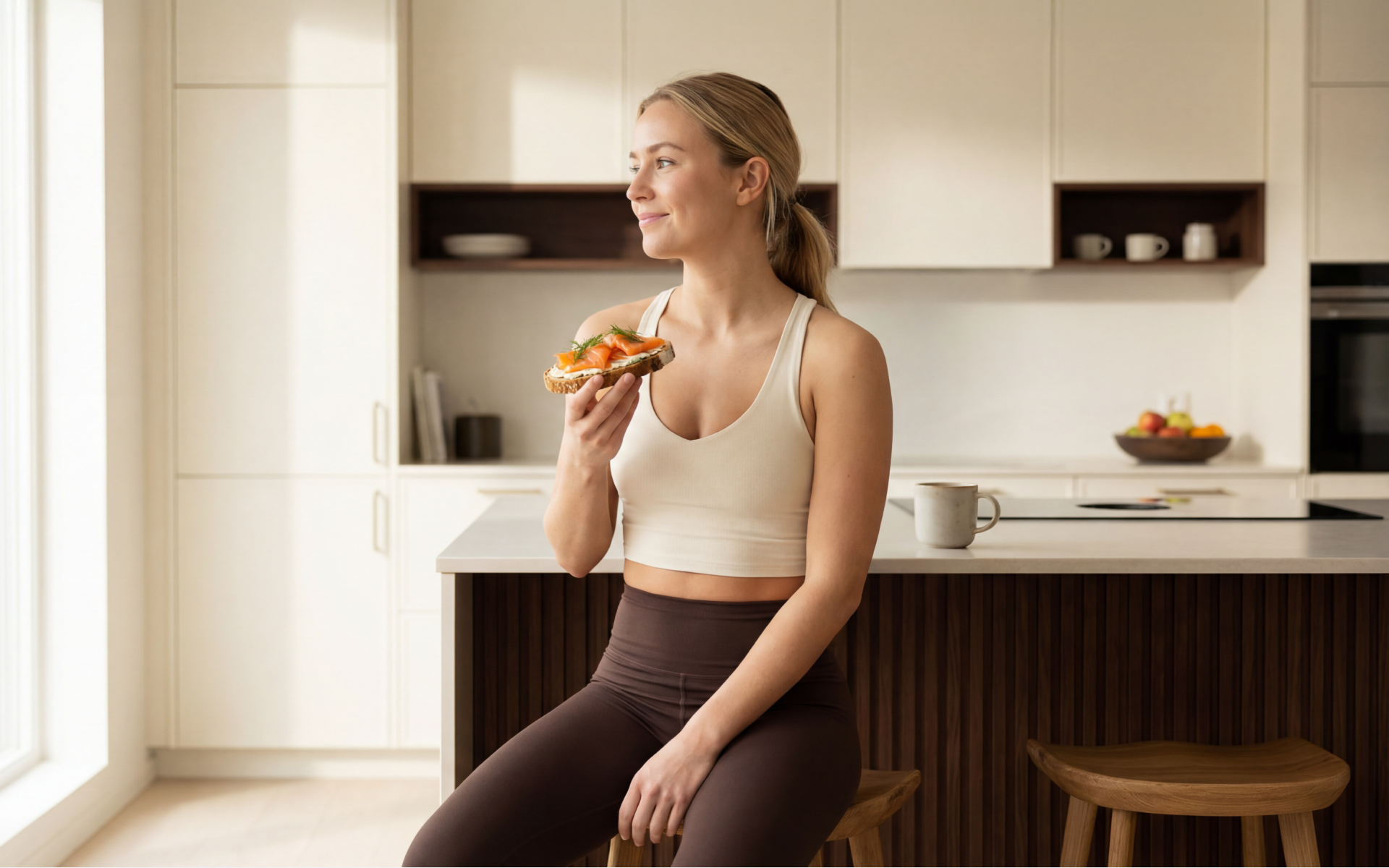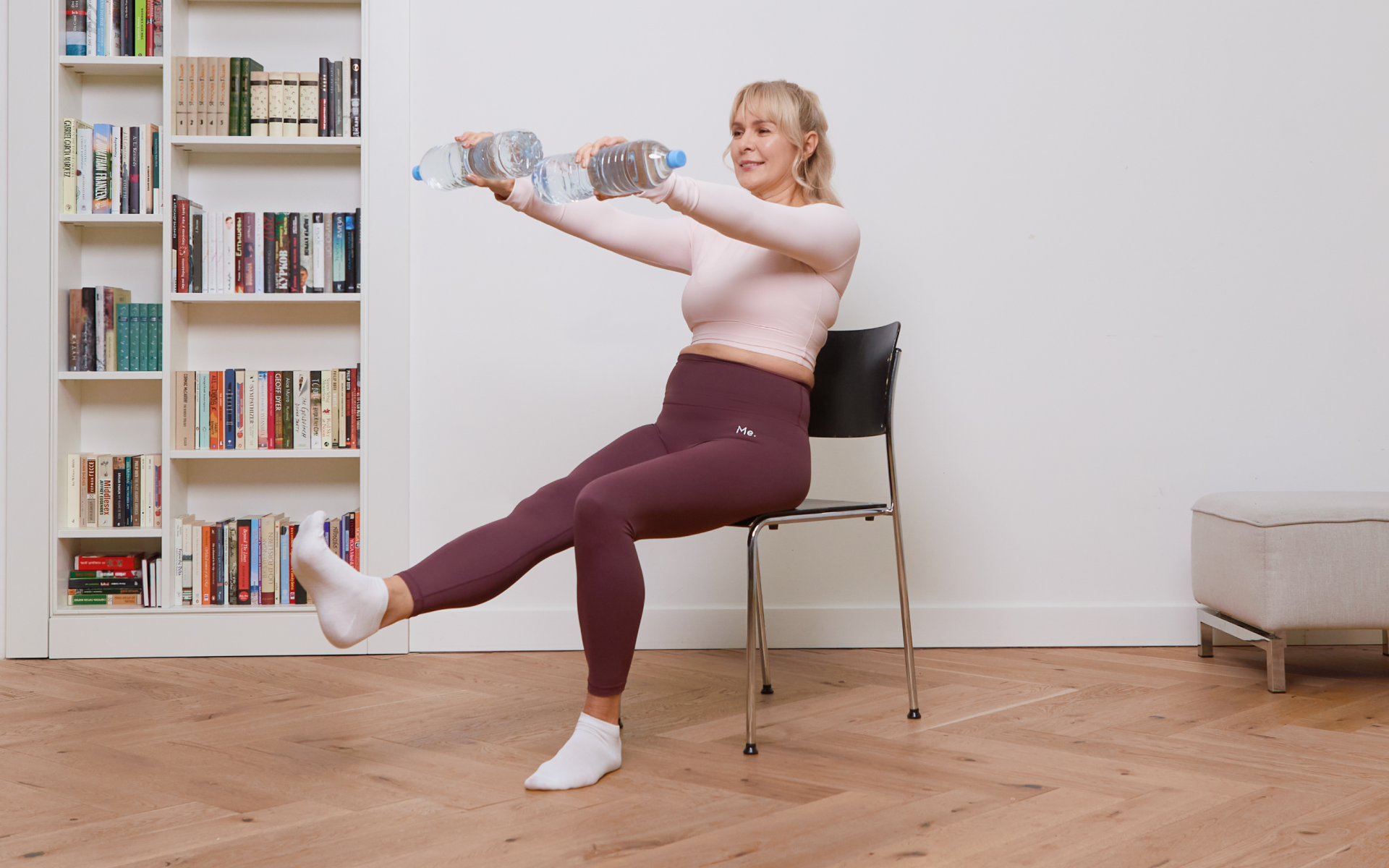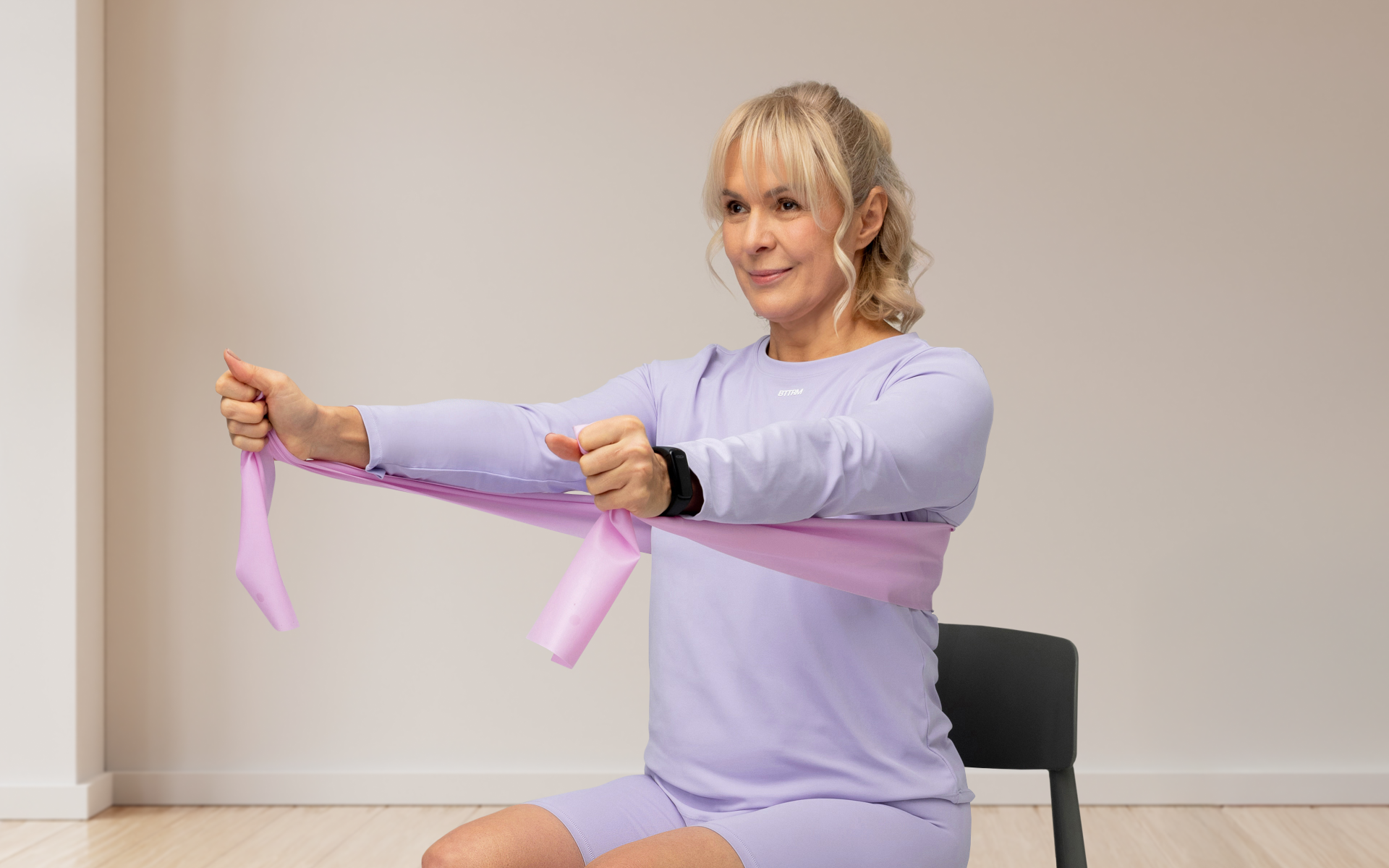Your 50s can be a beautiful chapter of independence, wisdom, and self-discovery.
Staying active becomes more important than ever during this life stage.
Exercise isn’t just about looking good; it’s about:
- Feeling stronger.
- Living a healthier life.
- Maintaining long-term mobility.
How does running stack up against other forms of exercise for a woman in her 50s?
Is it safe?
What are the potential benefits and challenges?
And how can you make running work for you, regardless of age?
Here’s what you need to know:
Is 50 Too Old To Start Running?
You’re never too old to start running. For women entering their 50s, running can offer a wide range of benefits, although it’s important to recognize its potential challenges.
Age is undeniably a factor in fitness, but it’s hardly an obstacle. The Centers for Disease Control and Prevention (CDC) and other health organizations emphasize that regular physical activity is crucial for maintaining overall health as we age (1).
Any exercise benefits:
- The muscles
- The bones
- The heart
- The mind
Research has shown that aerobic activities like running reduce the risk of chronic diseases such as Type 2 diabetes, cardiovascular disease, and osteoporosis (2)—all common concerns for women over 50.
A study published in the Journal of Geriatric Physical Therapy also found that older individuals who exercise regularly have better mobility, balance, and cognition than sedentary peers (3).
The Upside Of Running For Women In Their 50s
Cardiovascular Health
Running is an outstanding way to strengthen the heart and improve circulation.
Studies show that aerobic exercises can:
- Lower blood pressure
- Improve cholesterol levels
- Decrease the risk of coronary artery disease (4)—conditions that tend to become more common in midlife.
Bone Health
Postmenopausal women often experience low bone density due to reduced estrogen levels. Running is a weight-bearing exercise to help maintain bone mass.
A 2018 study in the Journal of the Menopause Society highlighted that high-impact exercises can significantly reduce the risk of osteoporosis (5). These experts also consider running to be a high-impact exercise.
Reasons why BetterMe is a safe bet: a wide range of calorie-blasting workouts, finger-licking recipes, 24/7 support, challenges that’ll keep you on your best game, and that just scratches the surface! Start using our app and watch the magic happen.
Mental Health Benefits
Women often experience hormonal and mental shifts during their 50s, including higher levels of stress, anxiety, or even depression.
Increased endorphin production during running, due to “the runner’s high,” can help mitigate these effects. Running improves sleep, which can benefit women dealing with insomnia or irregular sleep patterns during menopause (6).
Weight Management
Metabolism often slows in midlife, making weight management a challenge. Running is one of the most calorie-efficient exercises, helping to counteract those age-related metabolic changes (7).
Social And Community Engagement
Many women in their 50s enjoy participating in running clubs or charity races.
The social aspect adds a layer of fulfillment and accountability, keeping these women consistent in their fitness pursuits.
Read more: Move More at Home with an Indoor Walking App That Actually Works
Challenges Of Starting Running At 50
Risk Of Injuries
If new runners of any age fail to follow a well-designed training plan, they are at high risk of overuse injuries.
This risk is worse for women in their 50s who have bone density changes or osteoarthritis.
It is worth your time to develop a proper training plan with one or all of the following:
- A coach or fitness expert
- Your own research to mitigate these risks
You must also get adequate rest time and wear proper footwear.
Recovery Time
Recovery takes longer with age, as muscles and tissues repair more slowly (8).
Overtraining or skipping rest days can lead to fatigue or chronic injuries, such as plantar fasciitis or shin splints. Therefore, it is essential to prioritize rest days (10).
Heart Health Concerns
Although running is excellent for heart health, women over 50 should consult their doctor to assess any pre-existing cardiovascular conditions before starting.
If running is too risky, you should swap high-intensity running for safer alternatives like brisk walking or interval jogging.
Access To Time And Motivation
For many women in their 50s, juggling family, work, and other obligations can make it challenging to prioritize running. However, you can integrate short but consistent runs into your daily routine more easily than lengthy sessions.
How Many Days A Week Should A 50-Year-Old Run?
The optimal number of running days per week for a 50-year-old depends on factors like fitness level, running experience, and health status.
However, research suggests that running 3-5 days a week strikes a healthy balance between gaining the benefits of running and allowing sufficient time for recovery.
The World Health Organization (WHO) guidelines recommend at least 150–300 minutes of moderate aerobic activity or 75–150 minutes of vigorous aerobic activity per week, coupled with muscle-strengthening activities on two or more days (11).
How Do I Start Jogging After 50?
The key is to start slow, choose the right gear, and listen to your body.
Here’s a step-by-step guide to help you get started safely and effectively:
- Get Medical Clearance Before Starting
Before beginning any new fitness activity, ensure your body is ready for the challenge.
- Consult your doctor. Schedule a checkup to discuss your plans and ensure that you do not have any underlying health conditions that may interfere with jogging.
- Ask questions. Ask about any limitations or specific guidelines you should follow while jogging.
- Mention any existing injuries. Your doctor may suggest modifications to prevent further injury.
1. Choose The Right Gear
Wear comfortable, supportive gear for a safe and enjoyable jogging experience.
- Invest in running shoes. Visit a running-specific store to get fitted for shoes that match your foot type and stride.
- Wear moisture-wicking clothes. These fabrics help regulate your temperature and keep you comfortable.
- Dress for the weather. Layer your clothes on cold days, and wear lighter clothes and sunscreen on warm or sunny days.
- Consider accessories. A fitness watch to track your progress and a hat for sun protection can be helpful.
2. Start With A Warm-Up Routine
Warming up prepares your body for exercise while reducing the risk of injury.
- Walk briskly. Start with 5-10 minutes of walking to increase your heart rate.
- Stretch dynamically. Perform leg swings, arm circles, or other movement-based warmups to loosen your joints and muscles.
- Include balance movements. Try toe taps or standing on one leg to improve stability, especially if you haven’t exercised in a while.
3. Begin With A Walk-Jog Plan
Ease into jogging instead of trying to run long distances immediately.
- Alternate walking and jogging. Start with a ratio of 2 minutes of walking to 1 minute of jogging.
- Set a time goal. Aim for a total of 15-20 minutes in the beginning.
- Gradually increase intensity. Over time, increase the jogging intervals and decrease the walking intervals.
- Listen to your body. Don’t push yourself to exhaustion during these early stages.
4. Focus On Proper Running Form
Paying attention to your running technique helps reduce strain and improves efficiency.
- Keep your body upright. Avoid slouching; a slightly forward lean is natural.
- Relax your shoulders. Tension in the shoulders can lead to discomfort.
- Land midfoot. Aim to land softly on the middle of your foot to prevent jarring impacts and improve running efficiency.
- Swing your arms naturally. Keep your elbows bent at about 90 degrees and move your arms in a relaxed, forward-backward motion.
5. Increase Intensity Gradually
Building endurance takes time. Avoid overexertion by progressing at a reasonable pace.
- Follow the 10% rule. Increase your weekly distance or time by no more than 10%.
- Add one challenge at a time. Focus on running faster, going further, or running for extended periods—not all three simultaneously.
- Take recovery days. Allow at least 1-2 days a week for rest or light activity, such as walking or yoga.
6. Watch For Signs Of Overexertion
Pay attention to your body as you build your jogging habits.
- Monitor breathing. You should be able to talk without gasping; if you can’t, slow down.
- Watch for pain. Stop jogging if you feel a sharp pain in your joints, muscles, or chest.
- Check your heart rate. Use a fitness tracker to ensure your heart rate isn’t exceeding the recommended range for your age during moderate exercise.
- Take rest days. If you feel fatigued, overly sore, or unmotivated, take additional rest time to recover.
7. Cool Down And Stretch Post-Run
Cooling down helps your body recover and prevents stiffness.
- Walk it out. Spend 5 minutes walking and gradually slowing your heart rate down.
- Stretch major muscle groups. To release tension, stretch your calves, quads, hamstrings, and hip flexors.
- Hydrate and refuel. Drink water and consider eating a protein-rich snack to aid muscle recovery.
8. Build A Sustainable Routine
Consistency is key to making jogging a long-term habit.
- Pick a schedule. Choose specific days and times of the week to jog.
- Set realistic goals. Aim for at least 3 weekly sessions as you build endurance.
- Find motivation. You can jog with a friend, join a running group, or celebrate small milestones to stay motivated.
- Track your progress. Use a journal or app to monitor your workouts and improvements.
9. Enjoy The Process
Jogging is about improving your health and having fun. To create a positive experience, practice patience and focus on the long-term running after 50 woman benefits.
- Listen to music or podcasts. Pick something upbeat to keep you motivated.
- Focus on how you feel. Notice the mental and physical benefits after each session.
- Celebrate your wins. Acknowledge your achievements, whether jogging longer or simply sticking to the routine.
Read more: Indoor Walking for Seniors: Tips, Benefits, and Safety Measures
Does Running Reduce Belly Fat?
Running can help reduce belly fat, but understand that fat loss, including in the abdominal area, depends on achieving an overall calorie deficit.
A calorie deficit occurs when you burn more calories than you consume, prompting your body to use stored fat for energy. Running is an excellent calorie-burning exercise that plays a significant role in creating this deficit.
Running promotes calorie burn by increasing your heart rate and engaging large muscle groups. The faster and longer you run, the more calories you burn, helping to tip the scale toward fat loss (7).
Additionally, it can boost your metabolism, primarily when running at higher intensities, such as intervals or sprints.
The higher intensity can increase your body’s calories even after your workout.
However, belly fat reduction isn’t solely about running.
Targeted fat loss in specific areas, commonly called “spot reduction,” is a myth.
Fat loss occurs throughout the body. To effectively reduce belly fat, you must focus on overall fat reduction through consistent exercise and a balanced, calorie-conscious diet.
Pairing running with other activities, like strength training, is also highly beneficial.
Strength exercises build muscle, which increases resting metabolism (12), further aiding fat loss.
A diet rich in whole, nutrient-dense foods while limiting processed, sugar-laden options will complement the calorie deficit created by running.
Ultimately, running is a powerful tool for fat loss, but it works best with a healthy diet and varied physical activity.
Can A 50-Year-Old Woman Run A Marathon?
A 50-year-old woman can run a marathon with preparation and a strong mindset.
To prepare and run a marathon successfully, consider:
- Physical Health: Consult your doctor to ensure you’re fit for long-distance running, especially if you have any preexisting conditions or haven’t exercised regularly.
- Training: Commit to a structured training program that prioritizes gradual endurance-building, typically 16–20 weeks long. Include rest days and cross-training to avoid overuse injuries.
- Gear: Use proper running shoes and comfortable attire to support long runs.
- Diet and Hydration: Focus on a well-balanced diet rich in carbs, proteins, and fats to fuel your training and stay hydrated during and after runs.
- Listen to Your Body: Watch for signs of pain or fatigue, and adjust your pace or schedule as needed to prevent injury.
Discover aqua jogging workouts that challenge your body, refresh your routine, and renew your energy for fitness.
Whether you’re a workout beast or just a beginner making your first foray into the world of fitness and dieting – BetterMe has a lot to offer to both newbies and experts! Install the app and experience the versatility first-hand!
Is Running Enough For A Long, Healthy Life?
While running promotes overall well-being, research suggests that a balanced and varied exercise routine is the key to achieving optimal health and longevity (13).
A study in Frontiers in Physiology highlights that combining aerobic and resistance training delivers superior cardiovascular health outcomes compared to either type of training alone (14).
The aerobic and resistance training combination also improves:
- Metabolism
- Muscle mass
- Overall functional fitness.
Combining aerobic and resistance training offers a powerful approach to improving overall fitness and health. Further research has discovered this combination enhances body composition by reducing body fat and increasing lean body mass (15).
If running is your primary exercise, integrate other activities to fill in the gaps.
Here’s an example of a weekly schedule:
- Monday: 30–40 minutes of running +20 minutes of yoga or stretching
- Tuesday: Strength training focused on upper body and core
- Wednesday: Low-impact activity (e.g., cycling or swimming)
- Thursday: Run intervals (alternating sprints and recovery running) + stretching
- Friday: Rest day or mindfulness activity like meditation or tai chi
- Saturday: Strength training focused on lower body
- Sunday: Long, slow-paced run or brisk walk
This varied approach ensures you build endurance, strength, flexibility, and balance while allowing for proper recovery.
We’ve discussed what Running 2 Miles A Day Transformation can do for your body and mind—uncover the surprising changes waiting for you.
Running can have anti-aging effects (16). It improves cardiovascular health, enhances muscle strength, and supports bone density. It also boosts collagen production, improves skin elasticity, and promotes mental well-being by reducing stress and improving mood. Daily running sessions can increase the risk of overuse injuries, such as shin splints or joint pain. As you age, you need more recovery time. Rest days are essential to allow muscles and joints to recover, rebuild, and adapt, minimizing the risk of long-term damage while improving performance. Daily running is not necessary or advised for most runners who do not compete at a high level. However, very experienced runners, particularly those who compete at a high level (collegiately or professionally), may be able to run every day with a properly structured training plan. Research suggests runners tend to live longer. Studies show consistent running improves heart health, reduces the risk of chronic diseases like diabetes and hypertension, and enhances overall longevity (16). Moderate-intensity running for about 2–3 hours per week offers several lifespan benefits. Running burns more calories quickly and provides more significant cardiovascular benefits. However, walking provides lower ground reaction force and, therefore, lower peak impact on the bones, joints, muscles, and other structures of the lower body and pelvis. Walking has a lower incidence rate of overuse injuries and can be ideal for those with chronic joint pain or sensitivity. Both activities have health benefits, and the choice depends on fitness levels, goals, and physical condition.Frequently Asked Questions
Is running anti-aging?
Why is it not good to run every day?
Do runners live longer or shorter?
Is running better than walking?
The Bottom Line
Running after 50 offers significant benefits, such as enhancing cardiovascular health, boosting mental well-being, and aiding in weight management. To avoid injuries and support overall fitness, balance running with proper rest and cross-training.
Listen to your body and adjust the intensity or frequency based on your fitness level and health. When approached mindfully, running can be an enriching and sustainable way for women over 50 to stay active, healthy, and fulfilled.
DISCLAIMER:
This article is intended for general informational purposes only and does not serve to address individual circumstances. It is not a substitute for professional advice or help and should not be relied on for making any kind of decision-making. Any action taken as a direct or indirect result of the information in this article is entirely at your own risk and is your sole responsibility.
BetterMe, its content staff, and its medical advisors accept no responsibility for inaccuracies, errors, misstatements, inconsistencies, or omissions and specifically disclaim any liability, loss or risk, personal, professional or otherwise, which may be incurred as a consequence, directly or indirectly, of the use and/or application of any content.
You should always seek the advice of your physician or other qualified health provider with any questions you may have regarding a medical condition or your specific situation. Never disregard professional medical advice or delay seeking it because of BetterMe content. If you suspect or think you may have a medical emergency, call your doctor.
SOURCES:
- Benefits of Physical Activity (2024, cdc.gov)
- Aerobic exercise: Top 10 reasons to get physical (2023, mayoclinic.org)
- The Effect of an Exercise-Based Balance Intervention on Physical and Cognitive Performance for Older Adults A Pilot Study (2010, journals.lww.com)
- Aerobic Exercise Reduces Blood Pressure in Resistant Hypertension (2012, heart.org)
- Effect of 2 years of endurance and high-impact training on preventing osteoporosis in postmenopausal women: randomized clinical trial (2018, journals.lww.com)
- A Scoping Review of the Relationship between Running and Mental Health (2020, mdpi.com)
- The effect of regular running on body weight and fat tissue of individuals aged 18 to 65 (2023, jphysiolanthropol.biomedcentral.com)
- The effect of fatigue on running mechanics in older and younger runners (2023, nih.gov)
- How often should you take a rest day? (2023, uclahealth.org)
- WHO Guidelines on Physical Activity and Sedentary Behaviour. (2020, nih.gov)
- Increasing muscle mass to improve metabolism (2013, nih.gov)
- Cross Training (2020, orthoinfo.aaos.org)
- Effects of combined aerobic and resistance training on gut microbiota and cardiovascular risk factors in physically active older women: A randomized controlled trial (2022, frontiersin.org)
- The Effects of Combining Aerobic and Heavy Resistance Training on Body Composition, Muscle Hypertrophy, and Exercise Satisfaction in Physically Active Adults (2023, mdpi.com)
- Running slows the aging clock, Stanford researchers find (2008, med.stanford.edu)


